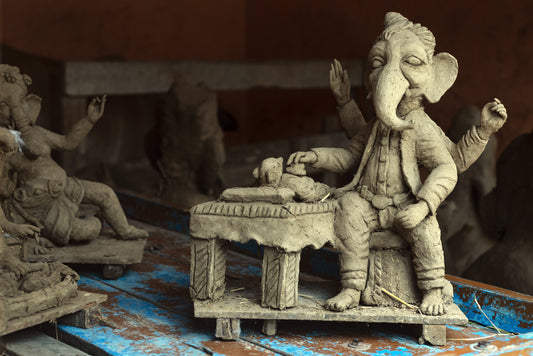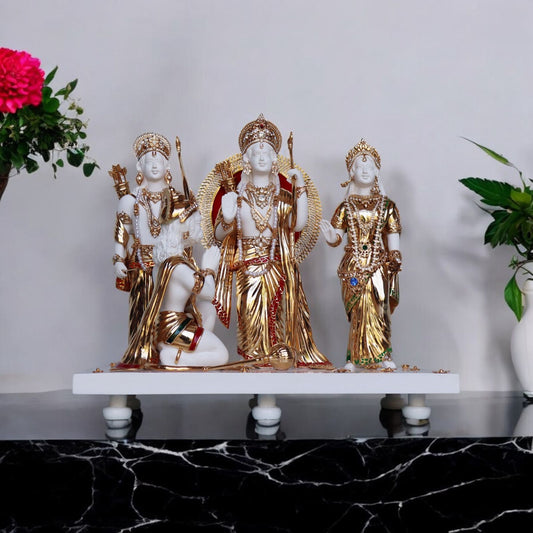The Importance of Goddess Lakshmi and Lakshmi Pujan During Diwali

Diwali celebration is one of the most popular festivals in India. Some beliefs claim that it marks the day of the divine wedding between Lord Vishnu and Goddess Lakshmi. Another belief mentions it is the day Lord Rama and Maa Sita returned to the holy city of Ayodhya after 14 long years.
Regardless of one's beliefs, the festival carries immense cultural significance. Central to this celebration is the worship of Goddess Lakshmi, the deity of wealth, prosperity, and good fortune. Lakshmi Pujan, performed on the third day of Diwali, is a deeply revered ritual where devotees invite the goddess into their homes and hearts, seeking her blessings for material and spiritual prosperity.
Who is Goddess Lakshmi?
Goddess Lakshmi is the consort of Lord Vishnu, one of the main deities in Hinduism. She embodies wealth, beauty, and abundance. According to ancient Hindu texts, Maa Lakshmi is associated with abundance of wealth and prosperity, and her blessings can bring financial security and prosperity into the devotees lives.
Attributes and Symbols of Lakshmi
- Lotus: She has lotus in both of her palms, which reflects spiritual enlightenment. It reflects that despite a lotus blossom in the muddy water, it remains untouched by its surroundings.
- Gold Coins: She also has a pot full of gold coins that represent the wealth and prosperity that she provides.
- Elephants: Some iconography of the goddess also showcases one or two elephants that signifies wisdom, strength, and diligent work.
Historical and Mythological Background
Samudra Manthan
In Hindu mythology, Goddess Lakshmi emerged from the ocean during the Samudra Manthan, a battle between the Gods and the Asuras. This event marks her eternal association with wealth and abundance. She chose Lord Vishnu as her divine consort, symbolizing the union of wealth with righteousness and dharma (virtue).
The Return of Rama and the Celebration of Diwali
After 14 years in exile and fighting Ravana, Lord Rama returned to Ayodhya with her wife Maa Sita, brother Shri Lakshman, and loyal servant Lord Hanuman. The citizens of Ayodhya celebrated the return by lighting diyas and bursting crackers, a tradition that continues to date.
The Rituals of Lakshmi Pujan During Diwali
Lakshmi Pujan is one of the most important rituals for Hindus during Diwali. Houses are cleaned and decorated. New home decor is introduced as the family prepares. Here’s a breakdown of the key rituals involved:
Preparation for Lakshmi Pujan
It is believed that Goddess Lakshmi only enters homes that are clean and well-kept. Therefore, people spend the days leading up to Diwali cleaning, decluttering, and decorating their homes.
Along with cleaning and decluttering, colourful rangoli patterns and designs are made at the entrance of homes to invite positive energy. Rangoli is not just a decorative element but is believed to attract positive fortune.
Oil lamps (diyas) are also lit in every corner of the house, especially near the main entrance, to ward off darkness and evil. This symbolises the triumph of light over darkness.
Key Rituals and Offerings
- Setting Up the Puja Altar: The idol or picture of Goddess Lakshmi is placed alongside Lord Ganesha (the remover of obstacles). Lord Ganesha is worshipped first to ensure that all challenges in the path of wealth and prosperity are removed.
- Offerings (Naivedya): Devotees offer sweets, fruits, flowers, rice grains, kumkum (vermilion), and turmeric to the goddess. In some households, specific foods like khoya (milk solids) sweets are prepared to impress the Goddess.
- Lakshmi Aarti: The aarti is an essential part of the puja. It is performed to honour the goddess and seek her blessings. The aarti is often accompanied by the ringing of bells and chanting of Lakshmi mantras to invoke her divine presence.
Special Traditions
- Opening Windows and Doors: During Lakshmi Pujan, it is a common practice to keep all doors and windows open, symbolically inviting the goddess into the house.
- Offering Money and Jewellery: In many households, people place money and gold/silver jewellery before the goddess, seeking her blessings to multiply their wealth and protect their assets.
Shopping for Lakshmi Pujan From Satguru’s
Here are some of the best decorative items that you can buy from Satguru’s:
Lakshmi Idol
We have an amazing collection of Lakshmi idols. You can choose brass lakshmi, our Lakshmi idol skilfully crafted using resin.
Our recommendation:
Lotus Laxmi In Metallic Finish by Satgurus
You can also buy Elephant idols from Satguru’s that can be accompanied by the Lakshmi idol as shown in Goddesses’ iconography.
Ganesha Idol
Our Ganesha idol collection contains both traditional and contemporary designs, but for the sake of Lakshmi Pujan, we can stick with traditional iconography.
Our recommendation:
Brass Pagdi Ganesha B by Satgurus
Diyas

Lighting diyas during puja represents the triumph of light over darkness, purifies the environment, and signifies devotion, creating a sacred ambiance for the presence of deities. Oil diya is lit to get rid of evil, while a ghee diya is perfect for spiritual upliftment.
Our recommendation:
Diya With Lakshmi Motif by Satgurus
Conclusion
The worship of Goddess Lakshmi during Diwali is a beautiful blend of tradition, spirituality, and culture. Not only does the iconography depict her as a wealth-provider, but it also symbolises spiritual elevation and the ability to resist negative surroundings and influences.
Visit Satguru’s to buy the best items for your Lakshmi Pujan. Along with spiritual items, you can also check out Satguru’s to buy home decor items for renovating your interior. Shop Now.





